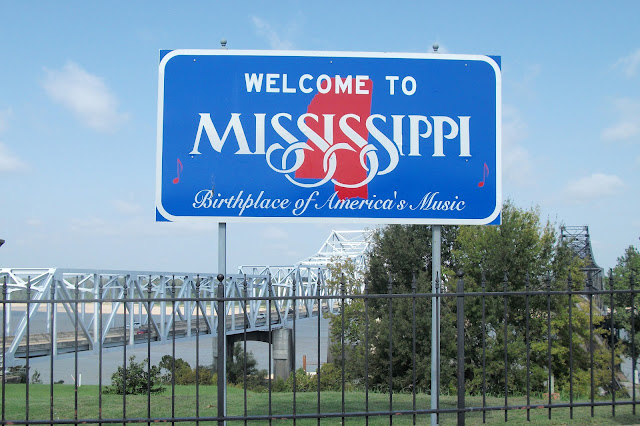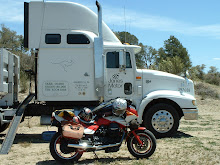On 1 September we delivered an Army truck and generator to Fort Polk in Louisiana.
It was the Labor Day long weekend here and we couldn't load until Tuesday morning in West Monroe, Louisiana. It was hot and humid, so rather than stay in the truck we got a motel for three nights. Took the bike off the truck on Sunday morning. The roads around central northern Louisiana are mostly straight and not much to see. We headed east to the Mississippi River. Went through some small towns, areas of cotton and rice growing.
In Lake Providence, Louisiana we had lunch at The Dock. Ate some local food - catfish, crawfish pie and Louisiana crabcakes. Oh, so good! The restaurant markets its own spices called "Sho-Nuff", and we got some.
 |
| L to R: Catfish, Crawfish Pie, Louisiana Crabcakes. |
Stopped in the town of Transylvania, Louisiana - not much there except the cotton gin, Post Office and water tower.
Monday we got an earlier start to Vicksburg, Mississippi on the bike. There was nothing that interested us closer to Monroe and Vicksburg had always looked interesting from the highway.
First stop was the Mississippi Welcome Centre and picked up some brochures, so much to see and do, that we could only choose a few attractions.
Vicksburg features in US Civil War history.
Wikipedia: The Siege of Vicksburg (May 18 – July 4, 1863) was the final major military action in the American Civil War. In a series of maneouvers, the Union Army crossed the Mississippi River and drove the Confederate Army into the defensive lines surrounding the fortress city of Vicksburg, Mississippi.
When two major assaults against the Confederate fortifications were repulsed with heavy casualties, the besiege of the city began on May 25. With no reinforcement, supplies nearly gone, and after holding out for more than forty days, the garrison finally surrendered on July 4. This action yielded command of the Mississippi River to the Union forces, who would hold it for the rest of the conflict.
The Confederate surrender following the siege at Vicksburg is sometimes considered, when combined with the Confederate defeat at Gettysburg the previous day, the turning point of the war.
The city of Vicksburg would not celebrate Independence Day for about eighty years as a result of the siege and surrender.
In Vicksburg many antebellum homes (existing before the Civil War) and mansions had tours, we chose Cedar Grove Mansion. It is also an Inn and Restaurant.
Tourist Brochure: A magnificant 1840 Greek Revival mansion overlooking the Mississippi River on 5 acres with formal gardens, gazebos, fountains, courtyards which are a prelude to the mansion furnished with many original antiques, including gas-lit chandeliers. One of the largest and most elegant Bed and Breakfasts in the South.
It is a very beautiful mansion and I enjoyed our self guided tour. Some explanations and excepts from the tour guide pamphlet:
This mansion survived the Civil War mainly because it was taken by the Union Army and used as a hospital after the fall of Vicksburg. Also the owners wife was related to General Sherman of the Union Army. There is a cannonball lodged in the wall of the Gentleman's Parlour, it came through the front door (patched) and into the wall. Also a hole in the floor where a cannonball came through the front window. History says that the house was hit 41 times, but most all the hits were patched and repaired leaving just a few scars.
 |
| The cannonball is next to the small plaque. |
The draperies 'puddled' on the floor - this was a sign of wealth. The more your draperies puddled, the wealthier you were. Floor to ceiling windows - because each exit door had a tax placed on it, so they would lift a window half way up to go in and out of the house.
(Their wealth was obvious by excess fabric for the drapes, but they chose to go through a window instead of paying a tax on extra doors...?)
In the Ladies Parlour is a 'petticoat mirror', ladies could check their petticoats in the lower mirror.
 |
| Ladies Parlour petticoat mirror. |
 |
| The safe looks like a piece of dining room furniture. |
A Centennial Piano built in 1876 and made of rosewood, named 'centennial' because only 100 were made. and there are only three still in existence. Even though this piano has had some repairs, it appraised at over $1.5 million.
 |
| Centennial Piano. |
Website: The Grant Room ($180/$200 per night) furnished with the original antiques, and marbled bathroom with spa tub. Sleep in the same king canopy bed as General Ulysses S. Grant did.
Thirteen guest rooms and seven suites in the home, and seven cottage rooms in out buildings. Also seven cottages can be rented. Each of the original owners six children that reached adulthood had their own home built on the property.
Some of the grounds - the gazebos and ponds are original.

Our next tourist attraction was Biedenharn Coca Cola Museum. A restored 1890 building where Coca Cola was first bottled in 1894. The Museum contains a reproduction bottling works and Coca Cola memorabilia, and a 1900 soda fountain.
The restored candy store and office area will take you back to a simpler, sweeter time with furnishings and displays from the 1890s. We offer our visitors ice cream, fountain Cokes, Coke floats and a wide selection of Coke souvenirs.
Note: Coca Cola was created in Atlanta, Georgia in 1866 but sold only as a fountain drink until 1894 when Joseph Biedenharn thought of bottling Coke in the same manner he had been bottling soda water and offering it for sale to those who could not always make it to town to visit one of his three soda fountains.
Website: The marble soda fountain at the Museum is an excellent example of a turn of the century soda fountain. It was operated by a "soda jerk," so named because he would "jerk" on the one of the various levers or valves on the fountain to dispense Coca-Cola or one of the other flavours offered and the valve to dispense soda water. Usually, a “mixture” was served in glasses, often with a metal holder supporting the glass. Large blocks of ice were used to cool the contents of the fountain before it was dispensed.
Yes, we had Coca Cola floats at the end of the tour!
Took a drive past the Old Courthouse (circa 1858-1860), now a Museum. The most impressive antebellum structure in Vicksburg.
We didn't get to see much else in Vicksburg - we started heading back towards Monroe along the south side of the highway. More straight roads and not much to see and it was still hot and humid.
Loaded at Southern Apparatus in West Monroe on Tuesday morning - one generator and delivered it that night in Mayfield, Kentucky. It goes in a rail locomotive.
 |
| Huge radiators for CAT. |
Over to Gadsden, Alabama, ready to load the next morning. Jimmy was going from Louisiana to Maine and he stayed the night next to us at the truckstop in Gadsden.
Friday morning we loaded metal road works forms at S.I.P. Inc. That was a lot of work because it was all sharp edges that cut straps. We put pieces of carpet and edge protectors on all places the strap touched. If there is a cut 1/2 cm or it is frayed at all, the strap has to be thrown out, otherwise it is a violation.
S.I.P.Inc make Stay-in-Place metal bridge deck forms, they are high-strength, deep-corrugated, galvanized steel units designed to customer specifications and specifically tailored to meet federal and state highway department engineering criteria on a project specific basis. These permanent forms are designed to be placed between either structural steel or pre-stressed concrete bridge girders, speeding up new construction or rehabilitation on any concrete slab bridge deck.
On Saturday afternoon we stopped in Randolph, New York and parked the truck at a small truckstop there. One of Jim's friends who lives near there came and picked us up, and Jim borrowed his pick up truck (ute) for a quick trip to Buffalo - about 70 miles (120 kms), so he could visit his mother and I got to see Michele and Baillie (and the animals!). Stayed overnight then back to Merlin and Jody's on Sunday afternoon. Stayed Sunday night with them, then back in the truck at 5am.
 |
| Little Conewango Creek near Randolph, NY. |
 |
| The start of a beaver lodge in Little Conewango Creek. |
Monday we delivered the bulk of the S.I.P. shipment to a railway bridge in Bath, New York and the rest went to a highway bridge project near Buffalo. Over to Hamilton, Ontario and loaded a steel coil at US Steel Canada late that afternoon.
We try to avoid crossing at the Ambassador Bridge because it is usually congested, but it was less miles going through Detroit so we lined up with about 200 trucks on Monday night for Customs and Immigration clearance.
Website: The Ambassador Bridge is a suspension bridge that connects Detroit, Michigan, in the United States, with Windsor, Ontario, in Canada. It is the busiest international border crossing in North America in terms of trade volume: more than 25 percent of all merchandise trade between the United States and Canada crosses the bridge.
The bridge, over the Detroit River was completed in 1929—1,850 feet (564 m). The bridge's total length is 7,500 feet (2,286 m).
The four-lane bridge carries more than 10,000 commercial vehicles on a typical weekday.
(10,000 trucks per day; $10.75 fee to Customs and Border Protection - $107.500.00. Plus $18.50 bridge toll - $185,000.00. $292,500.00 per day just for trucks.)
Wednesday morning delivered the steel coil to a steel plant in Talladega, Alabama. Then over to Birmingham, Alabama and loaded 16 steel plates.
Thursday 13 September, delivered the steel plates in Fort Myers, Florida and arrived in Daytona Beach late afternoon.
Friday was busy getting my stuff out of the truck, lots of business to be done, and packing. Friday night we went to New Smyrna Beach to catch up with Ron, Gina, Tim, Helena and Derek for dinner at Peanuts.
Saturday I will be at the Orlando International Airport about 1.30-2.00 - and headed home! Flights are Orlando, Florida to Los Angeles, California, to Auckland, New Zealand, and arrive Brisbane, Queensland late on Monday morning 17 September.



















No comments:
Post a Comment